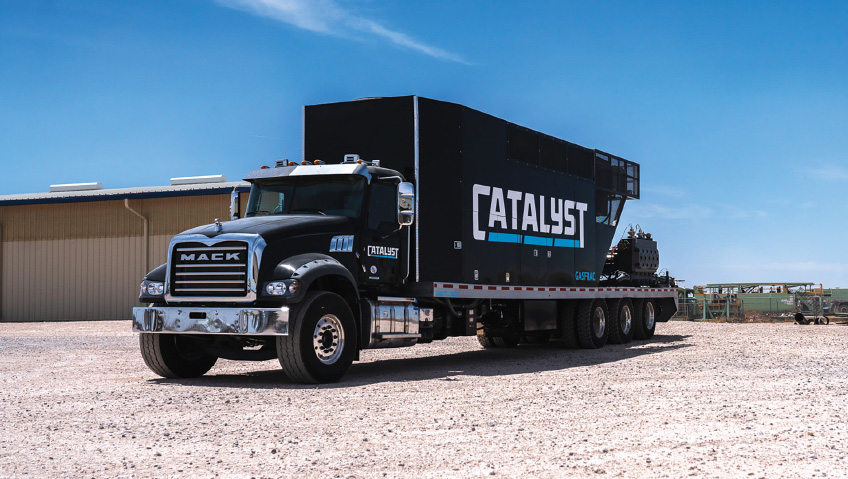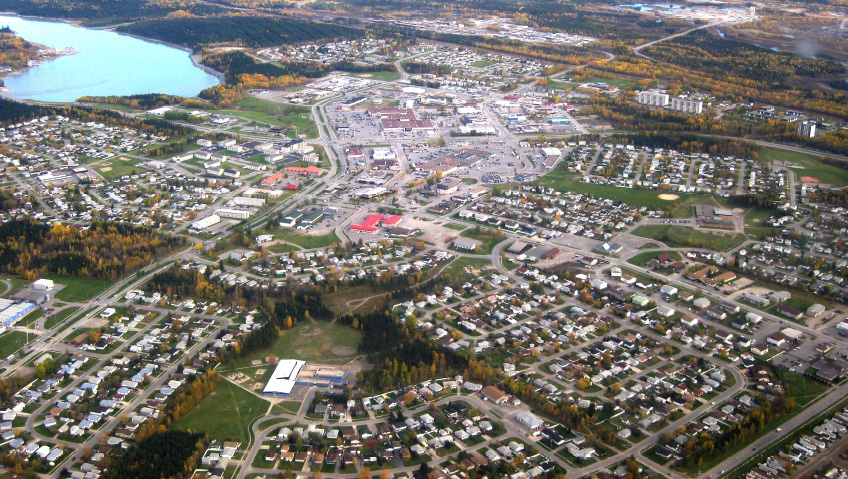Catalyst Energy Services of Odessa, Texas is preparing to launch a new version of its pioneering Vortex Prime pumping system into a tumultuous natural gas and oil market.
Catalyst provides crews and pumps for energy companies in the Permian Basin, a region straddling southeast New Mexico and West Texas that contains abundant oil and natural gas deposits. The firm has also been thinking about expanding into new locales as it tweaks its flagship product.
For the second-generation Vortex Prime, the company has “enhanced and optimized certain aspects of the technology. We were really proud of what we made, and we’re continuing to support that technology, but we saw the opportunity to improve on certain aspects of it. That’s probably been the biggest technological change at Catalyst in the last ten months or so,” explains Co-Founder and Chief Technology Officer Seth Moore.
Vortex Prime is used for hydraulic fracturing—fracking—a method of breaking up underground rock formations through high-pressure blasts of sand, water, and/or chemicals that are pumped down a wellbore. Once the rock has been penetrated, underlying natural gas and oil deposits are extracted. While fracking is not new, Vortex Prime, launched in 2022, was the industry’s first pumping system to feature direct-drive turbine technology. Pumps on the solution are fitted to military-grade turbines that are powered by natural gas.
The self-contained system offers up to 15,000 pounds per square inch of pressure and 25 barrels per minute per pump unit, depending on configuration. It produces 40 percent fewer emissions than traditional fracking fleets.
Vortex Prime also offers a speedy set-up time of two days, rather than four days for a standard fleet, and fewer cycles, which means less fuel consumption, less manpower, and fewer trips to and from the worksite. The system requires six to eight pumps as compared to 20 on a conventional fleet, reducing space requirements by over 50 percent. And its compact size means it can be used in tight quarters that conventional fleets cannot access.
The new, improved version, which will be released shortly, is also more reliable and safer than its predecessor, according to Moore. “We were able to upgrade some of the components [to have] more reliability under harsh working conditions,” he says. “We don’t always operate in the most pristine environments; the roads we travel aren’t always the smoothest, so having components that live up to the demands we put them through is really important.”
Vortex Prime has always been a safe system, but “a lot of the components have been configured in such a way to [ensure an even] higher degree of user safety,” adds Moore.
The company still manufactures the Vortex Prime system pump in Odessa and emphasizes rentals over sales. “We build it in-house. We feel we can build the quality in. We can control the build process better that way. We have a team of dedicated manufacturing professionals, most of [whom] worked in the field and have run the equipment,” he says. The company worries that quality might diminish if it handed over production to an outside firm.
As a pay-for-service business, Catalyst contracts its equipment and personnel to energy companies for fracking assignments. Its crews travel to the customer’s site, set up the Vortex Prime or another system—the company also has traditional diesel and dual fuel pumps on hand—and assist with hydraulic fracturing work. Catalyst has an ongoing partnership with GD Energy Products (GDEP), a firm that has been involved in the oil and gas equipment business since the Victorian era. The Vortex Prime system is currently fitted with a Thunder 5000 pump from GDEP, with 5,000 referring to the maximum horsepower of which the unit is capable.
“We continue to partner with them; it’s been a good partnership,” says Moore. “There are other players now that have technology that probably could compete with the Thunder 5000, where that wasn’t the case several years ago… but I still think we have the highest horsepower density of any technology available as far as horsepower per square foot of space.”
At the time we last spoke, Catalyst was entirely focused on the Permian Basin. While the region still offers an enormous amount of work for hydraulic fracturing firms and industry service providers, the company has broadened its horizons. “There’s been so much interest in what we’re doing outside the Permian Basin,” Moore says. “There are discussions about providing our service in other oil and gas basins [with clients] who see the value in what Vortex Prime brings to the table.”
More evaluation needs to be done, but Catalyst is at least pondering the possibility of opening new branches outside the Permian Basin. “If we go to the Northeast, we would have a branch somewhere in that area. If we go to the Rockies or outside the U.S., we would need a place” to establish operations, he explains.
Certainly, Catalyst has faced some major challenges recently due to developments in the natural gas and oil sector. “The market has really been saturated with excess capacity in the last 12 months,” Moore explains. This excessive capacity has meant less work for the company. Corporate consolidation within the Permian Basin has led to downsized fleets which has hurt it too. And the company is faced with another, rather unique problem: “We’re a victim of our own success. We’re much more efficient today than we were a year ago, from a pumping perspective and a pumping hours per month perspective. So, it’s taking fewer fleets to do the same amount of work that it took a year or two ago,” he says.
The number of personnel at Catalyst has fluctuated since the previous profile when the company had 185 employees. It currently has “close to 140 employees,” and is hiring again, Moore says. There are some job-specific positions, but in general the company looks for new hires with a good work history, a continuous improvement mindset, and a collaborative spirit. “I tell everybody, frac is a team sport. It requires all departments, everybody working seamlessly in order to meet the efficiency demands that are required,” he explains. Catalyst has no intention of sitting on its laurels, as evidenced by moving ahead with enhancing its already impressive Vortex Prime solution.
Unsurprisingly, Catalyst cites innovation as a key company value. Other values prized by this team are integrity, respect, creativity, accountability, safety, communication, competition, and partnership. Keeping abreast of industry trends is also imperative, which is why Catalyst is paying close attention to the emerging trends known as simul-frac and e-frac. In a simul-frac process, two horizontal wells are utilized concurrently to enable simultaneous fracking.
“Simul-frac is continuing to grow… There are some efficiencies with simul-frac, where you’re fracking two wells at the same time. It requires fewer people and accomplishes more in the same amount of time,” states Moore.
E-frac refers to a pumping process that relies on electricity, not diesel or gas. While e-frac fleets produce fewer emissions and use less fuel than their conventional counterparts, they require onsite electrical generators to meet their high energy needs. Since it is a direct-drive system powered by natural gas-fed turbines, Vortex Prime does not require standalone electrical generators, switch gears, variable frequency drives, or similar components.
Vortex Prime is less complex, with fewer moving parts and more robust components than an e-frac fleet. Many e-frac components were designed for use in static sub-stations, not portable pumping systems that have to be transported on rough roads, Moore points out. As a result, “componentry life is greatly reduced, which drives a big operating expense for e-fleets that we don’t have. I think e-frac has its place,” he adds. “When it can tie into a micro-grid and get power, I think it makes sense, but when you have to generate your electricity onsite, and you have to move a generator set and all that associated componentry, it doesn’t make sense from a cost perspective or an efficiency perspective.”
Going forward, the company has to decide whether to expand its reach beyond the Permian Basin, the region where the company has earned its reputation. Regardless of how that decision plays out, Moore says that Catalyst will “continue to be an innovator, continue to offer world-class service, and continue to be viewed at the forefront of delivering the most efficient technology from an emissions, safety, and fuel savings perspective.”






